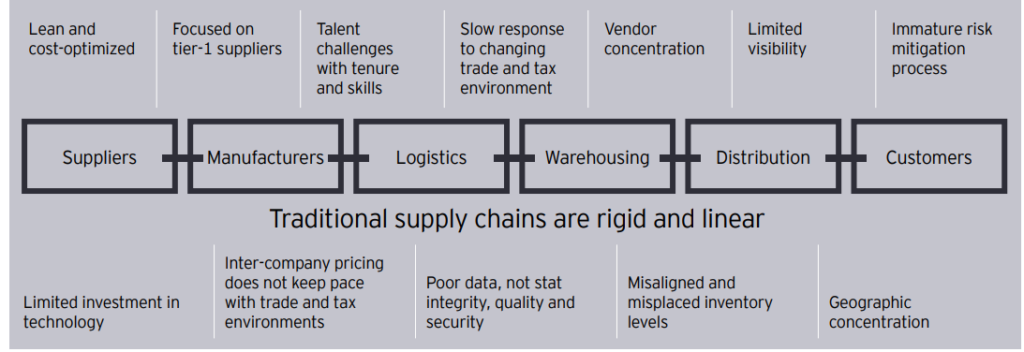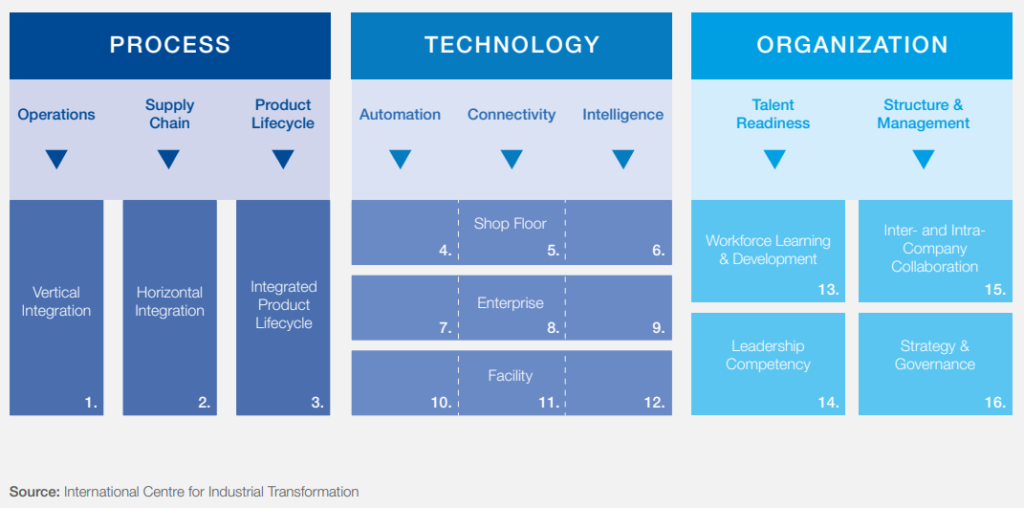The industrial revolution is shaping up. While production and capacity utilization rose above pre-pandemic levels in mid-year, a strong increase in new orders for all major sub-sectors signaled continued growth in 2022.
The industry can expect high uncertainty from a range of underlying factors globally. Business agility can be essential for organizations that want to not only operate through the chaos of an unusually rapid economic recovery but also to compete in the next phase of growth.
Manufacturers with digital maturity prior to COVID-19 have an advantage to some extent with greater resilience, as do those that accelerate digitalization in times of crisis.
Old Supply Chain Model

Taking a generic case: Company X in the food segment deals in international trade and yet uses some traditional methods of the supply chain which creates more carbon emissions.
The company wants to transform its digital process and enhance its working capability without losing data and reduce carbon emissions in order to maintain efficiency and smoothly transition from old methods to new innovative methods
Major challenges
Internal and external forces affect manufacturers’ manufacturing plants and the processes the employees use in them, ultimately changing the way the manufacturing processes work.
- Fluctuating market demand requires agility to increase production capacity. Prices of steel and other raw materials have risen amid shortages.
- Supply chain disruptions due to trade wars and raw material shortages globally require resilience to overcome them
- Regulatory penalties and requirements to fulfill the company promises of “Net Zero” while increasing sustainability.
- Be accountable to environmental initiatives to reduce emissions, energy consumption, and waste.
- Labor and workforce leaving.
- Policy initiatives and infrastructure investment risks.
Manufacturers should put more emphasis on updating and expanding their workforce digitization and retraining strategies.
With the advent of digitization, the scope of work and work arrangements are growing rapidly. . As manufacturers formalize digitization strategies to upgrade their production and business processes, there is also a need to re-examine how they organize their workforces and workspaces as working from a Distance is becoming more popular in the digital age.
Optimization Factors:

The manufacturing company X is actively looking for data-driven insights
to better understand how different food industry sectors across geographies are integrating manufacturing concepts and technologies to advance their digital transformation strategy.
Integrating digital functions and leveraging data can make supply chain management efficient and agile. Company X increasingly looking for an end-to-end solution, such as a digital control tower, which integrates all requirements across the supply chain and provides real-time insights across warehouse management, fleet management, intelligent capacity forecasting, decision-making, reporting, intelligent tracking, and returns management.
What do they need?
- AI to develop robust demand-forecasting models, which can promote efficient inventory management, improve working capital utilization and drive down logistics costs.
- Smart automation, including predictive maintenance and lesser human touch during manufacturing to accelerate operations and reduce error rates
- RFID to make product tracking more efficient and help in reducing in-store merchandising manipulation.
Supply Chain
Manufacturer X is remaking supply chains for advantage beyond the next disruption. Supply chain resilience has been a thread, and the challenges are acute and still unfolding.
- Purchasing manager reports continue to reveal systemwide complications from high demand, rising costs of raw materials and freight, and slow deliveries across the globe.
- Transportation challenges to export and supply material from one place to another.
- As demand outpaces supply, higher costs are more likely to be passed on to customers.
- Root causes for extended supply chain instability may include overreliance on low inventories, rationalization of suppliers, and hollowing out of domestic capability.
- Turnaround time is more and the speed of the process to produce the goods needs enhancement.
Solutions for The Supply Chain
- Enhance data integration for supply-and-demand visibility and planning.
- Integrating operational data for more transparency and insight into operations to improve the turnaround and delivery time.
- For example, centralizing a production tower can bring together data from different facilities, production lines, and equipment and visualize supplier dependencies and logistics impact.
- Digital supply networks and data analytics can be powerful tools for multi-level responses to disruptions.
- The relocation of components or even final assemblies could pick up momentum as the global supply and low inventory patterns continue to diversify.
- Rising wages and transportation costs globally make outsourcing or retail more competitive and organizations seek to avoid repeating mistakes of the past.
- Initiatives and investments to build resilience in the supply chain to produce high-quality goods.
- Assessing supply chains for food production and using the latest tech-enabled systems.
Blockchain

Another potentially game-changing technology is blockchain, but it is not always a practical solution. “More and more companies are looking at blockchain technology to improve the way they track their supply chains, but for that to work X, The company needs multiple vendors and many vendors can’t use it, especially the ones with less digital advancements.
Another method to improve visibility is to deploy technology to create a carrier network where connectivity is central. Connecting suppliers and improving transparency, but changing the attitudes of companies is a challenge, as they do not want to share more information about the volume and price of companies.
Blockchain can track the entire process footprint from manufacturing to distribution channel monitoring.
To invest in digitization and connectivity across all functional areas, If integrated effectively, these investments can also improve agility and accelerate innovation. Technology investment is also needed to reduce the risk of cyber attacks.

The advantage of smart contracts in the blockchain is that multiple blockchains (e.g. Enterprise Ethereum, Tendermint, Cosmos, and Polkadot) execute smart contract code in the virtual machine of each blockchain node after transaction validation.
Smart Contracts
Smart code execution validates transactions and prevents subversion by external code running in processes outside of the blockchain. In addition, smart contracts in effect form the backbone of the blockchains. The newly added process must be completed using external code.
External distributed applications use the native smart contracts of the blockchain in the overall process architecture.
Protecting Confidential Information
Adoption of blockchain-enabled smart contracts. The standard must include supply chain-specific data elements that can be shared by multiple parties between smart contract parties or within a specific supply chain, without exposing proprietary information about their rights and/or sensitivities to the company.
As smart contract practice matures and can benefit from standards, in the absence of standards, Mutual agreement of terms and rights sharing can take place.
Cyber Security
Well-known cyberattacks across industries and governments over the past year have elevated cybersecurity to critical risk management statuses for most executives and boards.
The increase in threats during the pandemic has added to the business risk for manufacturers in ransomware crosshairs. Cybercriminals can cause damages beyond intellectual property theft and financial loss, using malware currently tied to AI and cryptocurrencies.
They can also shut down and disrupt the entire carrier network, impacting security as well as productivity. A range of regulations for different industries could be consolidated as part of the current administration’s “nationwide” approach to protecting critical infrastructure.
Challenges
- Phishing or ransomware-related security incidents have increased.
- Attack surface is expanding due to the connection of operational technology (OT), information technology (IT), and external network
- Requires more control.
- Legacy systems and technologies are not suitable for today’s complex network challenges.
- Remote working vulnerabilities leave manufacturers even more vulnerable to breaches.
- As insider threats also increase with workforce mobility, cybersecurity inside and outside organizations is increasingly important.
Solutions towards The Cyber Security
- Vigilance requires retooling, staff training, and monitoring within and across departments.
- Maintaining a high level of worker productivity or overall job efficiency is an ongoing goal in manufacturing facilities, with optimizing the uptime and performance of frontline workers.
- To improve employee availability and performance, manufacturers must make it easier for frontline employees to learn, collaborate, and share knowledge while keeping them engaged and delivering Flexible work arrangements.
- Manufacturers need to test not only their cyber defenses but also their resiliency. of their business in the event of a cyber attack.
- Allocate more intervention areas and tight security channel optimization.
- Digital surveillance and audit after a fixated time period.
- Focus on the security of their vendor ecosystem.
- Strict no breach policy.
- Enabling predictive on-time maintenance.
Future supply chains to be redesigned with new 3Rs:
- Responsive: The system responds to inputs from the external environment beyond The supply chain system relies on inputs such as customer order volumes, commodity prices, and freight rates for fulfillment. Therefore, businesses should appreciate the value of getting real-time updates on these items when upgrading from a legacy system.
- Reconfigure: Diversifying your supply chain isn’t as simple as building more factories in other jurisdictions. It involved rearranging and redesigning the functions of the system to be easier to use.
- Resilience: Think Big and Prepare to Build Resilience from the ground up, starting with organizational structure, business processes, and performance metrics for event assurance The next breakout is sustainable. There is no “one size fits all” for what it looks like, as every company is different.
ESG investments
The rapid proliferation of environmental, social, and governance factors is redefining and enhancing sustainability in manufacturing like never before.
As investors, boards, customers, employees, and policymakers continue to focus on ESG more attention to the industry. Along with an emphasis on performance reporting, as well as earnings, the manufacturer revealed.
To attract talent and meet workforce expectations, most manufacturers are making ESG efforts more visible.
- Depending on the manufacturer’s end market, environmental responsibility is increasingly prioritized.
- Using Blockchain. Optimizing each step and measuring the rate of Carbon burn.
- To develop and achieve net zero or carbon targets, more than organizations are contributing or identifying sustainability roles and initiatives and quantifying efforts and outcomes around energy use.
- With increasing attention to climate impact disclosures, more manufacturers are likely to operate or communicate environmental commitments in the areas of design, sourcing production, distribution, and after-sales.
- The rapidly changing ESG landscape may require close monitoring by 2022 for manufacturers.
- Many organizations voluntarily comply as part of a complex network of reporting regulations, ratings, and disclosure frameworks. But regulators across the globe are also moving toward disclosure requirements for more non-financial measures.
- Proactive approaches can help manufacturers stay ahead of change and create a competitive advantage.
Deploying a blockchain-enabled ecosystem where one can track the entire process from scratch to the distribution, X can optimize its key data points and keep a check on its carbon emissions too. Utilizing the data and training the workforce accordingly can help the company advance in its industry domain. Turning risk into an advantage and adapting new technology will transform the trends of the manufacturing industry and make it more sustainable to be optimized and manage.




